
Platz
1/144 P-47D Bubbletop Thunderbolt
| KIT #: | PD 13 |
| PRICE: | ¥1400 |
| DECALS: | Three options |
| REVIEWER: | Dan Lee |
| NOTES: | Two per box. |

| HISTORY |
The Republic P-47
Thunderbolt proved to be one of the most important plane types of WW2.
It was big, heavy, shorter ranged than the Mustang, and had a relatively
poor rate of climb, but it could take damage like almost no other plane and give
more than it took with 8 50 caliber MGs in the wings as well as drop a host of
rockets and bombs. Although it held
it’s own in air to air combat, the P-47 was more useful as fighter bomber,
providing close air support.
Hubert “Hub” Zemke
Among the many
pilots that made a name in the Thunderbolt was Hubert “Hub” Zemke, the famous
commanding officer of the 56th FG, the only FG in the 8AF that flew the P-47
during it’s entire time with the 8AF.
 Hub had the
difficult task of fighting the Germans, organizing his command and dealing with
stubborn USAAF bomber brass to improve fighter tactics.
Despite everything he did mostly what he set out to do as Hub earned
13-14+ kills flying with the 56th FG at a time when the Luftwaffe was still
combat effective and while stepping on a lot of senior brass’ feet to get his
ideas implemented as well as refuse assignments out of his beloved 56FG.
Hub had the
difficult task of fighting the Germans, organizing his command and dealing with
stubborn USAAF bomber brass to improve fighter tactics.
Despite everything he did mostly what he set out to do as Hub earned
13-14+ kills flying with the 56th FG at a time when the Luftwaffe was still
combat effective and while stepping on a lot of senior brass’ feet to get his
ideas implemented as well as refuse assignments out of his beloved 56FG.
The closest that
Hub was to losing anything was when 3rd ranking German ace Gunther Rall nearly
shot down Zemke in a May 12, 1944 dogfight that cost him two of his pilots, but
fortunately Rall was shot down by another pair of 56FG P-47s before that could
happen.
By Aug 1944, Hub
transferred himself to be commander of the 479th FG which had a less than
stellar record at that point.
This happened in part because David Schilling wouldn’t leave the 56FG to join
the 479FG and Hub wanted to fly the P-51 in combat.
He proved to be adept with a P-51 as he was a P-47 as he shot down 3 (or
4) more planes including an Me-262.
He flew with the 479th till October 1944 when the wing of his P-51 ripped off
due to turbulence, bailed out and was captured.
Hub spent the rest of the war as the senior officer in command of the
POWs at Stalag Luft 1 where he did his best to protect the men under his
command.
"He was an
extraordinary man, outspoken, courageous, and of unflagging personal integrity
and conviction. These qualities, which made him one of our greatest wartime
leaders, did not endear him to some of his military superiors and probably
denied him the rank and responsibilities he deserved. Nevertheless, he will
remain a symbol of military excellence long after others are forgotten."
-
John Frisbee (from
acepilots.com)
Glenn Eagleston
Eagleston was
originally an enlisted man who became an aviation cadet in 1942.
He joined the 354FG just as the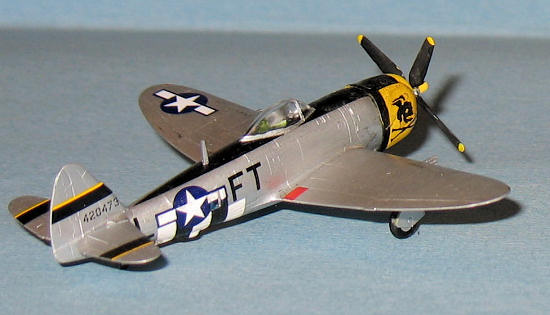 y
were to receive their beloved ‘ponies’, the P-51 Mustang.
He made a name for himself as a pilot when the 354FG was ‘loaned’ to the
8AF to help escort bombers during 1943-early 1944.
When the 354FG returned to the 9AF, they were forced to hand over their
Mustangs and replace them with P-47s which they flew till Feb 1945 when they
finally got back their P-51Ds.
During that time frame when they flew P-47s, Glenn Eagleston racked up zero
kills. It is somewhat ironic that
the 354FG “Pioneers” ace’s most famous plane is his uniquely marked P-47D with
the pirate’s skull and crossbones on the cowling.
Glenn Eagleston was the 9AF’s leading ace with 18.5 kills.
y
were to receive their beloved ‘ponies’, the P-51 Mustang.
He made a name for himself as a pilot when the 354FG was ‘loaned’ to the
8AF to help escort bombers during 1943-early 1944.
When the 354FG returned to the 9AF, they were forced to hand over their
Mustangs and replace them with P-47s which they flew till Feb 1945 when they
finally got back their P-51Ds.
During that time frame when they flew P-47s, Glenn Eagleston racked up zero
kills. It is somewhat ironic that
the 354FG “Pioneers” ace’s most famous plane is his uniquely marked P-47D with
the pirate’s skull and crossbones on the cowling.
Glenn Eagleston was the 9AF’s leading ace with 18.5 kills.
He would later go
on to fly Sabres in
Information from acepilots.com
| THE KIT |
See
Scott’s preview
of the kit.
This is more my first foray into Lilliput modeling scales for aircraft. I’ve built smaller aircraft before when I created a carrier strike fleet to play with when I was a kid, but this is the first time that I actually took the effort to build something this small with a semblance of quality as an adult.
| CONSTRUCTION |
The kits are about
as straight forward as one can get.
Glue the fuselage halves together.
Glue the wing halves together. Glue
the wings to the fuselage. Thanks
to the well designed parts, there aren’t that many seams to deal with.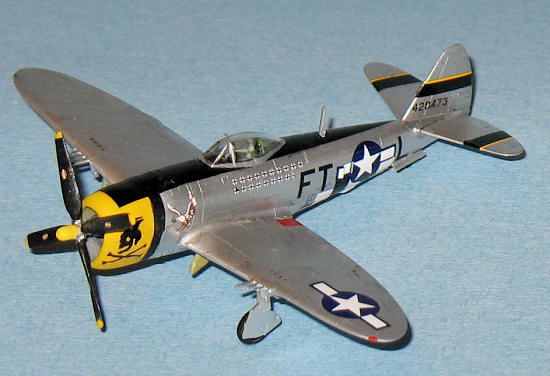
I cut off the pitot
tubes on the wings because otherwise it would make them impossible to fill and
sand them.
As my standard
operation procedure with NMF models, I let the models marinate for a few weeks.
I have found that this generally prevents phantom seams from appearing as
the join is fully cured although it increases the build time.
The seams were
filled in with CA glue and were carefully sanded using 400 wet dry grit
sandpaper. They were further
polished with micromesh sanding pads of various grit (2400-12000) as they were
NMF and any scratches would look way out of scale on the surface.
I left the stabs off because they would get in the way of the decaling and painting.
| COLORS & MARKINGS |
Paint
This spring was
unusually wet. Considering that all
three schemes were NMF, this posed a problem as any metallic lacquer produces a
better smoother finish in a drier climate than a wet one.
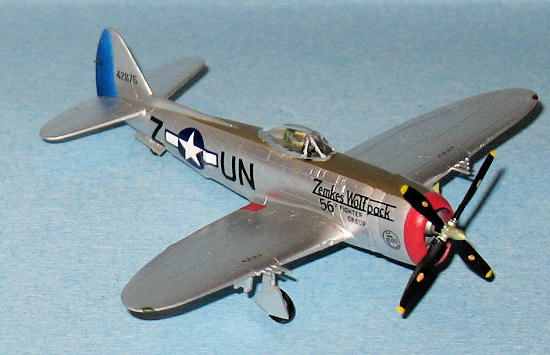 Several weeks
after the planes were put together, I finally got a dry weekend to spray on NMF
the planes and various parts with Tamiya TS-30 Old Silver from the can.
It took a couple of weeks (waiting for a dry and non-busy weekend) of
gentle polishing using 4000, 6000, 8000 and 12000 grit micro sanding cloths and
repainting to get the finish I wanted (ie:
good and smooth.) I thought
it would be easier than that, but it was just like working on a 1/48 NMF plane.
I thought about doing different panel lines, but I opted not too as I
thought it to be over done in such a small scale.
Several weeks
after the planes were put together, I finally got a dry weekend to spray on NMF
the planes and various parts with Tamiya TS-30 Old Silver from the can.
It took a couple of weeks (waiting for a dry and non-busy weekend) of
gentle polishing using 4000, 6000, 8000 and 12000 grit micro sanding cloths and
repainting to get the finish I wanted (ie:
good and smooth.) I thought
it would be easier than that, but it was just like working on a 1/48 NMF plane.
I thought about doing different panel lines, but I opted not too as I
thought it to be over done in such a small scale.
After that I took
both of the cowlings (masked off the nose of one of them) and sprayed on some
Tamiya XF-2 Flat White. One cowling
was sprayed gloss yellow and the masked cowling was sprayed with gloss red.
Once done, I hand painted the black cowl flaps of Glenn Eagleston’s plane
using Tamiya Flat Black.
I did a lot of hand
painting. The cockpits and seats
were painted XF-5 flat green. The
instrument panels were painted flat black.
For a brief moment, I thought about adding details to the cockpit, but I
realized that was just insane.
Other people might have the steady hands and the patience of someone who can
paint a picture on a grain of rice, but I am not one of those folks so I passed
on that idea. The Canopies were
hand painted with a very steady hand using Citadel Mithril Silver.
Again I thought about masking them and painting them with an airbrush,
but sanity stopped that brainwave.
The interior of the gear bays were hand painted Tamiya Flat Yellow Green
(chromate yellow.)
The rudder of the
P-47M was masked off and sprayed with flat white and then blue.
 I passed on
a gloss coat and opted instead to go with the bare paint due to the size of the
decals.
I passed on
a gloss coat and opted instead to go with the bare paint due to the size of the
decals.
Decals
The decals actually
went on bare paint without much trouble.
After enduring building several models that had way too many stencils for
my taste, I found the 1/144s to be enjoyable to decal (?!?) and easy to do (even
the prop stencils.) Most went on
without much effort and no silvering using MicroSet.
The only ones I had a little difficulty with were the insignia on the
side of the aircraft near the supercharger exhaust vents and the D-Day Stripes.
Those were put down with a bit of Solvaset and any alignment problems
were dealt with using a paint brush and some Citadel Bone White paint.
Weathering
I opted to weather Glenn Eagleston’s with a light watercolor wash, but not Hub’s P-47M as it was flown after the war when he returned from the POW camp. Doesn’t seem to make much of a difference at this scale.
| FINAL CONSTRUCTION |
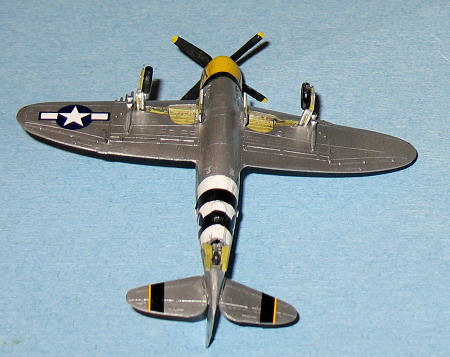 The stabs,
landing gear, tail wheel well, pylons, gear doors and antennas were added on
both models. The inner gear doors
were butt joined to the model using Superglue.
The stabs,
landing gear, tail wheel well, pylons, gear doors and antennas were added on
both models. The inner gear doors
were butt joined to the model using Superglue.
I thought about
replacing the pitot tubes that I cut off, but I passed on that idea as there is
no way I could drill a hole cleanly on the outer edge of the wing and anything I
glued on would stick out so I decided not to replace them.
Finally, the props
were painted (airbrush and hand painted), the prop stencils were added (!) and
pushed into the engine mount. I
left the bombs and rocket tubes off.
| CONCLUSIONS |
I
must say that my foray into Lilliput modeling was fun and rather interesting.
The models are very well detailed considering the scale and the
construction was rather easy. I
also learned that painting NMF in any scale is a pain especially if the weather
is not cooperating.
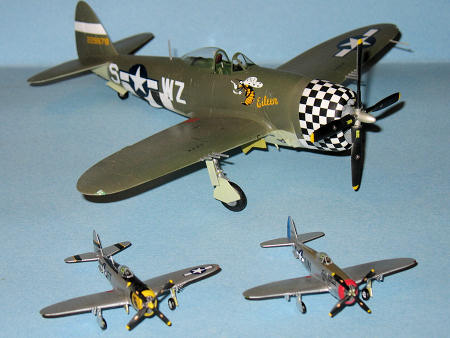 If you want
to build an air force that could stop Gulliver then I heartily recommend the
Platz 1/144 series of airplane kits.
If you want
to build an air force that could stop Gulliver then I heartily recommend the
Platz 1/144 series of airplane kits.
Kinda embarrassed that it took me 3 months to build to really two tiny planes though. (and you should be. Ed ;0). In the photo to the right, the gargantuan plane is 1/48
July 2009
Copyright ModelingMadness.com
Thanks to www.platz-hobby.com for the preview sample. Get yours today at your local shop or have them order it in for you.
If you would like your product reviewed fairly and fairly quickly, please contact the editor or see other details in the Note to Contributors.